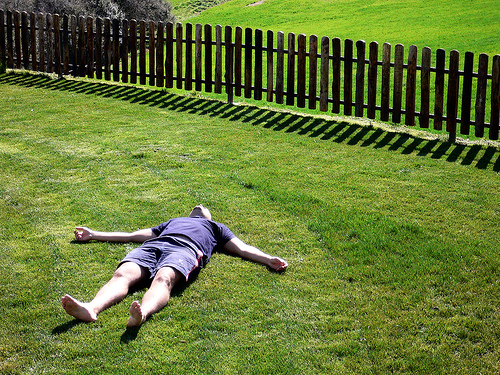
While I was driving home from my appointment I couldn’t help but feel nervous that I would forget to do something: peel the price tag off a thing I just bought in case somebody saw how much it cost.
I pulled onto a sidestreet and grabbed the plastic bag from the back seat. In it was a puck-sized container of a high-end hair paste. I scratched the little white sticker off. It was $35.00, and now only I knew.
Some paranoid financial conditioning somewhere in my head had me thinking it had been an extravagant purchase. But I thought about it for a minute and realized that no, for what it does for me, it’s some of the best value I’ll ever get for thirty-five bucks.
I’m 31 years old and it wasn’t until I started going to a well-reputed salon and buying 35-dollar hair paste that I finally began to really like my hair. This was a year ago. My mop had always been a point of self-consciousness for me. I liked myself, but never got along with my hair. It had evolved over the years, from crunchy gel spikes to a #2 buzz cut to a polite crop, but it was always a liability. I felt faintly uneasy about it, all the time. That problem spread itself across many thousands of days of my life, taking a little (sometimes a lot) of enjoyability from each of them.
Thinking back, I can’t even guess how many completely useless 35-dollar purchases I’ve made in my life — shirts I never wore, books I never read, drinks I didn’t need to drink, restaurant meals I could have made myself. When I consider what it really does for me, this hair paste is an astoundingly good investment. Read More

Just a quick shoutout to a certain demographic. If you create as a habit, hobby or job — writing, visual arts, music, design, whatever — I think this will mean something to you. If you once did but don’t any more then it may be even more relevant.
I don’t remember where I first saw it but it’s been making the rounds in the social media channels:
“Nobody tells this to people who are beginners, I wish someone told me. All of us who do creative work, we get into it because we have good taste. But there is this gap. For the first couple years you make stuff, it’s just not that good. It’s trying to be good, it has potential, but it’s not. But your taste, the thing that got you into the game, is still killer. And your taste is why your work disappoints you. A lot of people never get past this phase, they quit. Most people I know who do interesting, creative work went through years of this. We know our work doesn’t have this special thing that we want it to have. We all go through this. And if you are just starting out or you are still in this phase, you gotta know its normal and the most important thing you can do is do a lot of work. Put yourself on a deadline so that every week you will finish one story. It is only by going through a volume of work that you will close that gap, and your work will be as good as your ambitions. And I took longer to figure out how to do this than anyone I’ve ever met. It’s gonna take awhile. It’s normal to take awhile. You’ve just gotta fight your way through.”
-Ira Glass
Your taste is why your work disappoints you.
I guess this is a fact of life for creatives and we ought to be relieved by all it explains. It’s why it can be so hard to put your ass in the chair and make something — it’s painful to make something that doesn’t meet your standards, and those of us who are new to our respective arts don’t often hit the marks we set for ourselves.
It also explains how some really untalented writers and musicians and are more confident and less inhibited about self-promotion than the good ones. Low standards, met easily. If you’re self-conscious about showing your work, good, there’s a reason for that. Bad artists are bad because they don’t know what good looks like. Read More

Almost every day ends the same, with me lying unconsious on top of my favorite possession — my pillowtop queen.
There are exceptions, such as when I travel, where I end up unconscious on some other horizontal surface, but it’s as sure a rule as any that no matter what kinds of wild or unpredictable events happen during the day, the conclusion is quite predictable: me, horizontal and comatose.
I know it’s the same for you, and everyone else too. Just about everything else between us is different though. There are seven billion people in the middle of their lives at any given moment, whose days differ from each other in almost every respect. The events and thoughts that fill a normal day are so distinct to each individual that it’s probably impossible for any one person to imagine quite how it feels to live a day in the life of another.
The early-rising Chinese fishmongress couldn’t possibly guess what happens between dawn and dusk in the life of a Seattle studio guitarist, or vice-versa. But neither would even a close friend of yours have anything but the most basic idea of what a normal day is like in your shoes. The details of your job, your clothes-choosing process, the emotional feel of your morning routine, the recurring memories that comfort you or bother you — all of it is familiar to you and utterly foreign to everyone except you.
The waking part of each of our lives is necessarily different from anyone else’s, particularly given that most of our experience consists of what is completely private: our thoughts and the feelings that come with them. Yet with few exceptions, each of us will end the day by sinking willingly into some kind of surface, and letting consciousness finally run out of gas. Read More



 I'm David, and Raptitude is a blog about getting better at being human -- things we can do to improve our lives today.
I'm David, and Raptitude is a blog about getting better at being human -- things we can do to improve our lives today.
It all pretty the opposite if you're not in the US :) Since 2022 I've changed 3 countries and I'm planning to emigrate to the fourth one. I've had so much novelty and so many things to adapt to. However, time had never run so fast for me as in 2022...